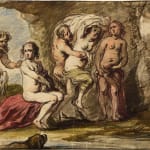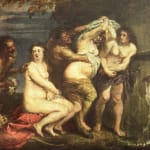
Peter Paul Rubens
Diana seduced by Pan
Formerly Kaiser-Friedrich-Museum, Berlin; destroyed in 1945.
Jan Boeckhorst (Münster 1604 - 1668 Antwerp)
Johann Boeckhorst was the second oldest of twelve children; his family belonged to Münster’s highly respected citizens (Honoratioren). The spelling of his name varies from Boichorst and Bockhorst in Münster; to Boeckhorst (used in two of his testaments), Bronckhorst or van Boeckhorst in the Netherlands. Among artists he was known as “Lange Jan” (‘tall John’ due to his height). He is thought to have arrived in Antwerp around 1626 to start his artistic studies. (Before that time, Boeckhorst was a canon in the Jesuit order.) Nothing much about his education and training is known until 1633-1634, when he joins the guild of St. Luke in Antwerp as ‘Jan Borckhorst’ and paid the same 26 guilders as Van Dyck for example. It is believed Boeckhorst worked closely with Anthony van Dyck at some point, presumably between 1627 and 1632, as the two collaborated on several works and Boeckhorst also made copies after van Dyck. The latter’s influence on Boeckhorst was in any case substantial.
Boeckhorst was a versatile artist, producing portraits, history paintings with mythological and religious subjects as well as genre scenes and allegories. He also produced designs for at least one set of tapestries, depicting the myths of Apollo, as well as several designs for publishers and printmakers. . Boeckhorst’s first known dated painting dates to 1646, twenty years after his arrival in Antwerp. As only very few signed and dated paintings exist, it has proved difficult to attribute works with certainty to the artist. However, it is known that he collaborated on numerous occasions with landscape painters such as Jan Wildens and Jan Brueghel the Younger or with the still-life painter Frans Snijders, providing often large-scale figures to their compositions.
Provenance
Private collection, FranceLiterature
E. McGrath e.a., Corpus Rubenianum Ludwig Burchard, vol. XI, Mythological Subjects, vol. 1, 2016, 382.
- X
- Tumblr




